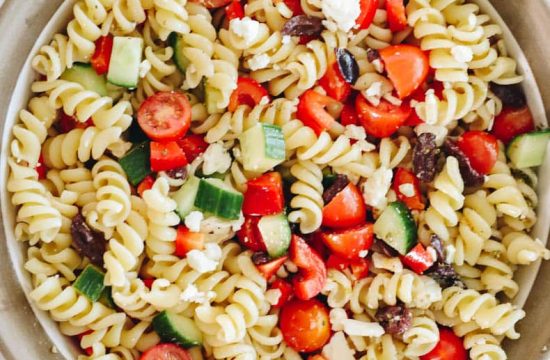
Breakfast really is the most important meal of the day, and studies show that what you eat in the morning can have a huge impact on how you feel throughout the day. If you’re hungry and low on energy a few hours later, you might be making these common breakfast mistakes.
01
You skimp on fiber

Fiber improves gut health and lowers blood sugar levels and cholesterol. But even if you eat a nutrient-packed diet, you might still be missing out on the recommended daily amount. Most adults need a minimum of 25 to 38 g of fiber daily. A high-fiber breakfast will fill you up. Plus, fiber slows the body’s absorption of carbs, so you don’t get a sugar spike followed by a quick crash. Don’t wait for lunch and dinner to eat high-fiber foods like whole grains, chia and flax seeds, nuts, and fruits and vegetables. This Chia Seed Pudding contains 6 g of fiber per serving!
02
You stick to breakfast foods

Typical low-protein, high-sugar breakfast foods like instant oatmeal, bagels, cereal, and pancakes set you up for sugar cravings and low energy for the rest of the day. If you’re not a fan of eggs, protein smoothies, or Greek yogurt, shake things up by eating dinner for breakfast. Assemble a grain bowl with leftover lean or plant-based proteins, whole grains, and vegetables for a quick balanced meal.
03
Your meal timing is off

Meal timing is more important than you might think. Eating according to circadian rhythms may improve blood sugar regulation, heart health, inflammation, and gut health. Breakfast resets your circadian clock, which regulates sleep, hormones, and metabolism. To get the health benefits of meal timing, consider trying time-restricted eating. One popular option is 16:8 intermittent fasting, when you eat all your meals within an eight-hour window during the day. For example, you could break your fast at 9 am and eat your final meal of the day around 4:30 pm.
Not so fast
Each person’s dietary needs are different. Chat with a dietitian or other health care practitioner before diving into intermittent fasting.
04
You miss out on protein

A protein-rich breakfast can help keep blood sugar low, especially when you eat protein with healthy fats. Most healthy adults need at least 0.8 g to 1 g of protein per kg of body weight each day. But, to build muscle, you’ll need 1 to 1.6 g of protein per kg of body weight. The body can only use about 20 g of protein at one time to build muscle, so divide your total requirements over three meals.
05
You skip breakfast

You might not be meeting your daily vitamin and mineral requirements if you skip a nutrient-packed breakfast. Studies show that people who eat breakfast have healthier overall diets and better blood sugar control. So, if you’re not hungry in the morning, try cutting out night eating or extending your overnight fast to 12 to 16 hours.
06
You don’t plan ahead

A breakfast plan that fits your lifestyle is one of the best ways to avoid other common breakfast mistakes. Plan meals for the days when you need a quick and easy breakfast. Prep ahead by washing and chopping fruits and vegetables, making a batch of egg muffins, whipping up yogurt overnight oats, or hard-boiling a few eggs for the week.
07
You make an all-fruit smoothie

Fresh fruit is loaded with fiber, vitamins, minerals, and antioxidants. Fruit is a good thing, but all-fruit smoothies are low in protein and fiber. One smoothie typically contains several pieces of fruit, so you get a bigger sugar load than from a piece of whole fruit. Level up your smoothie by blending low-sugar fruits such as berries with protein powder or Greek yogurt. For bonus points, add veggies like frozen cauliflower, which adds milkshake-like creaminess to any smoothie.
08
You count calories

What you eat matters as much as how much you eat. One hundred calories of sugar and 100 calories of healthy fats or proteins do not affect your body in the same way. According to the Institute of Medicine, your daily calories should be about 45 to 65 percent from carbohydrates, 10 to 35 percent from protein, and 20 to 35 percent from fat. For optimal nutrition, your meals should have roughly the same macro distribution.
09
You choose the wrong breakfast bar

Before you grab a breakfast bar, check the nutrition label. Some bars are loaded with sugar and are more like desserts, even popular brand names that you may think are healthy. Other bars don’t pack the calories and macro punch to replace a meal. When you’re reading nutrient labels, steer clear of bars with a lot of added sugar and have very little protein. Instead, look for high-protein bars with at least 3 g of fiber per serving, low or no added sugars, and no hydrogenated vegetable oils.
10
You wait for lunch to add color

According to the World Health Organization, adults need at least five servings of fruit and non-starchy vegetables a day. Instead of waiting for lunchtime to add fruits and veggies to your plate, get a head start with breakfast. Throw some berries and nuts on plain yogurt, add vegetables to a healthy smoothie (don’t forget the protein), or make a vegetable omelet.











